White-winged chough facts for kids
Quick facts for kids White-winged chough |
|
|---|---|
 |
|
| Conservation status | |
| Scientific classification | |
| Genus: |
Corcorax
|
| Species: |
melanorhamphos
|
The white-winged chough (Corcorax melanorhamphos) is a special bird found in Australia. It's one of only two birds left in a family called the Australian mud-nest builders. This bird is the only type in its group, called Corcorax.
It lives in southern and eastern Australia. Even though it looks a lot like the European chough, they are not closely related. This is an example of convergent evolution, where different animals develop similar features because they live in similar ways.
Contents
Understanding White-winged Chough Names
Scientists give animals special names to help identify them. This is called taxonomy. The white-winged chough was first described in 1817 by a French scientist named Louis Jean Pierre Vieillot. He called it Coracia melanorhamphos. Over time, its name changed a few times until Gregory Mathews gave it its current name in 1912.
The name melanorhamphos comes from ancient Greek words. Melano- means 'black' and rhamphos means 'beak'. So, its name means "black-beaked."
This bird belongs to a family known as the mud-nest builders, or Corcoracidae. The other bird in this family is the apostlebird (Struthidea cinerea). They look different but act in many similar ways. The mud-nest builder family is part of a larger group that includes crows, ravens, shrikes, and other birds.
It's important to know that the white-winged chough is not closely related to the European chough or the Alpine chough. These European birds are part of the crow family. The similar looks, like their dark feathers and curved beaks, happened because of convergent evolution. This means they developed similar features independently.
What White-winged Choughs Look Like

White-winged choughs are easy to spot, but people sometimes confuse them with crows. They are large, black birds, about 45 centimeters (18 inches) long. This makes them a bit smaller than a raven but a little bigger than an Australian magpie.
They have bright red eyes and a thin, slightly curved beak. When they get excited, their red eyes can look even bigger and brighter. When they fly, you can clearly see large white patches on their wings. This is how they got their name!
Their calls are also unique. They make a harsh alarm call and a soft, descending piping sound. This piping call is special and helps you know it's a white-winged chough in the wild.
White-winged Chough Behavior
White-winged choughs don't fly very often. They mostly walk on the ground. They move with a special swagger, looking for food like worms, insects, seeds, and snails. They usually do this in a loose group, calling softly to each other. If one bird finds a lot of food, the others will quickly come to share it.
These birds are very social and live in groups of about 4 to 20 birds. These groups are usually made up of the children of one pair of choughs. They are also very protective of their home area.
Sometimes, choughs will even "kidnap" young birds from other families. They do this so these new young birds can help their own family raise chicks next year.
What White-winged Choughs Eat
White-winged choughs look for food in leaf litter and old wood. They eat things like termites and beetles. They also eat seeds from many different plants, including various grasses and native Australian plants. They even eat seeds from plants that were brought to Australia from other places.
They enjoy a wide variety of insects and other small creatures. This includes centipedes, millipedes, beetles, cockroaches, termites, grasshoppers, flies, butterflies, moths, ants, bees, and wasps. In some areas, they will come close to people to find extra food.
White-winged Chough Reproduction
White-winged choughs raise their young together as a group. All the birds in the family help to care for the chicks. This process takes several years because young birds need to learn how to find food in the dry Australian bush. Larger families have a better chance of successfully raising their young.
The breeding season is from August to December. Their nest is shaped like a deep cup. It's made of grasses held together with mud or sometimes animal waste. They build these nests in a tree fork, sometimes as high as 10 meters (33 feet) off the ground.
The female chough lays three to five cream-colored eggs. These eggs have dark brown and lavender spots and are about 30 mm by 40 mm in size.
All family members take turns sitting on the eggs to keep them warm. They also help to clean and feed the young birds. The group works together to protect the nest from animals that might try to eat the eggs or chicks.
Young choughs take a long time, about six to seven months, to become independent. But they are very helpful! The next year, they return to the nest to help raise the new generation of chicks. This communal nesting is very important. Groups of two or three birds almost never succeed in raising young on their own.
Images for kids
See also
 In Spanish: Corvino negro para niños
In Spanish: Corvino negro para niños








